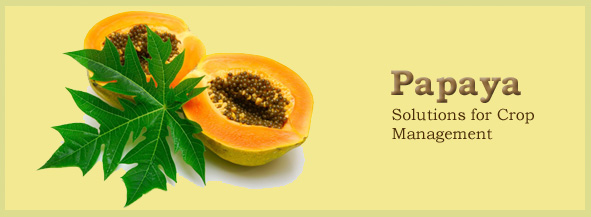Propogation
 Papaya is generally propagated by seeds obtained through
controlled pollination. The seeds loose viability very fast if
stored with high moisture content or if sun dried. The seeds
show orthodox storage behavior. Seeds dried to a moisture
content of (6 to 8%) and packed in moisture impervious container
like poly lined aluminum pouch with air tight sealing can be
stored at ambient conditions for short term storage (18 months)
and at 15oC for medium term storage (2-3 years).
Treating the seeds with 100 ppm GA for 8 hours enhances
germination. Seeds are sown in perforated polythene bags
measuring 20 × 15 cm size with 150 gauge thickness, filled with
equal proportions of farm yard manure, red soil and sand. Arka
microbial consortium @ 1 to 2 per cent (1 to 2 kg for 100 kg
potting mixture) may be added for healthy seedling production.
Two seeds are generally sown in each bag. The best time for
raising the seedling is between June to October. In eastern
parts of the country, seeds are usually sown from March to May,
so that the seedlings are ready for transplanting before the
onset of monsoon. In North India, where frost is common, seeds
are sown between February and April. Seeds germinate in about 2
to 3 weeks time depending on the temperature. In case of
dioecious varieties about 100 g of seeds and in case of
gynodioecious varieties 30 to 40 g of seeds are required per
acre. Generally, 45 to 60 days old seedlings are preferred for
planting. Over-aged seedlings either get damaged while
transplanting, or break in the field or results in poor
flowering and considerable in yield reduction. Of late,
vegetative methods are also being adopted for mass
multiplication in some countries. Papaya is generally propagated by seeds obtained through
controlled pollination. The seeds loose viability very fast if
stored with high moisture content or if sun dried. The seeds
show orthodox storage behavior. Seeds dried to a moisture
content of (6 to 8%) and packed in moisture impervious container
like poly lined aluminum pouch with air tight sealing can be
stored at ambient conditions for short term storage (18 months)
and at 15oC for medium term storage (2-3 years).
Treating the seeds with 100 ppm GA for 8 hours enhances
germination. Seeds are sown in perforated polythene bags
measuring 20 × 15 cm size with 150 gauge thickness, filled with
equal proportions of farm yard manure, red soil and sand. Arka
microbial consortium @ 1 to 2 per cent (1 to 2 kg for 100 kg
potting mixture) may be added for healthy seedling production.
Two seeds are generally sown in each bag. The best time for
raising the seedling is between June to October. In eastern
parts of the country, seeds are usually sown from March to May,
so that the seedlings are ready for transplanting before the
onset of monsoon. In North India, where frost is common, seeds
are sown between February and April. Seeds germinate in about 2
to 3 weeks time depending on the temperature. In case of
dioecious varieties about 100 g of seeds and in case of
gynodioecious varieties 30 to 40 g of seeds are required per
acre. Generally, 45 to 60 days old seedlings are preferred for
planting. Over-aged seedlings either get damaged while
transplanting, or break in the field or results in poor
flowering and considerable in yield reduction. Of late,
vegetative methods are also being adopted for mass
multiplication in some countries.
|








 Papaya is generally propagated by seeds obtained through
controlled pollination. The seeds loose viability very fast if
stored with high moisture content or if sun dried. The seeds
show orthodox storage behavior. Seeds dried to a moisture
content of (6 to 8%) and packed in moisture impervious container
like poly lined aluminum pouch with air tight sealing can be
stored at ambient conditions for short term storage (18 months)
and at 15oC for medium term storage (2-3 years).
Treating the seeds with 100 ppm GA for 8 hours enhances
germination. Seeds are sown in perforated polythene bags
measuring 20 × 15 cm size with 150 gauge thickness, filled with
equal proportions of farm yard manure, red soil and sand. Arka
microbial consortium @ 1 to 2 per cent (1 to 2 kg for 100 kg
potting mixture) may be added for healthy seedling production.
Two seeds are generally sown in each bag. The best time for
raising the seedling is between June to October. In eastern
parts of the country, seeds are usually sown from March to May,
so that the seedlings are ready for transplanting before the
onset of monsoon. In North India, where frost is common, seeds
are sown between February and April. Seeds germinate in about 2
to 3 weeks time depending on the temperature. In case of
dioecious varieties about 100 g of seeds and in case of
gynodioecious varieties 30 to 40 g of seeds are required per
acre. Generally, 45 to 60 days old seedlings are preferred for
planting. Over-aged seedlings either get damaged while
transplanting, or break in the field or results in poor
flowering and considerable in yield reduction. Of late,
vegetative methods are also being adopted for mass
multiplication in some countries.
Papaya is generally propagated by seeds obtained through
controlled pollination. The seeds loose viability very fast if
stored with high moisture content or if sun dried. The seeds
show orthodox storage behavior. Seeds dried to a moisture
content of (6 to 8%) and packed in moisture impervious container
like poly lined aluminum pouch with air tight sealing can be
stored at ambient conditions for short term storage (18 months)
and at 15oC for medium term storage (2-3 years).
Treating the seeds with 100 ppm GA for 8 hours enhances
germination. Seeds are sown in perforated polythene bags
measuring 20 × 15 cm size with 150 gauge thickness, filled with
equal proportions of farm yard manure, red soil and sand. Arka
microbial consortium @ 1 to 2 per cent (1 to 2 kg for 100 kg
potting mixture) may be added for healthy seedling production.
Two seeds are generally sown in each bag. The best time for
raising the seedling is between June to October. In eastern
parts of the country, seeds are usually sown from March to May,
so that the seedlings are ready for transplanting before the
onset of monsoon. In North India, where frost is common, seeds
are sown between February and April. Seeds germinate in about 2
to 3 weeks time depending on the temperature. In case of
dioecious varieties about 100 g of seeds and in case of
gynodioecious varieties 30 to 40 g of seeds are required per
acre. Generally, 45 to 60 days old seedlings are preferred for
planting. Over-aged seedlings either get damaged while
transplanting, or break in the field or results in poor
flowering and considerable in yield reduction. Of late,
vegetative methods are also being adopted for mass
multiplication in some countries.